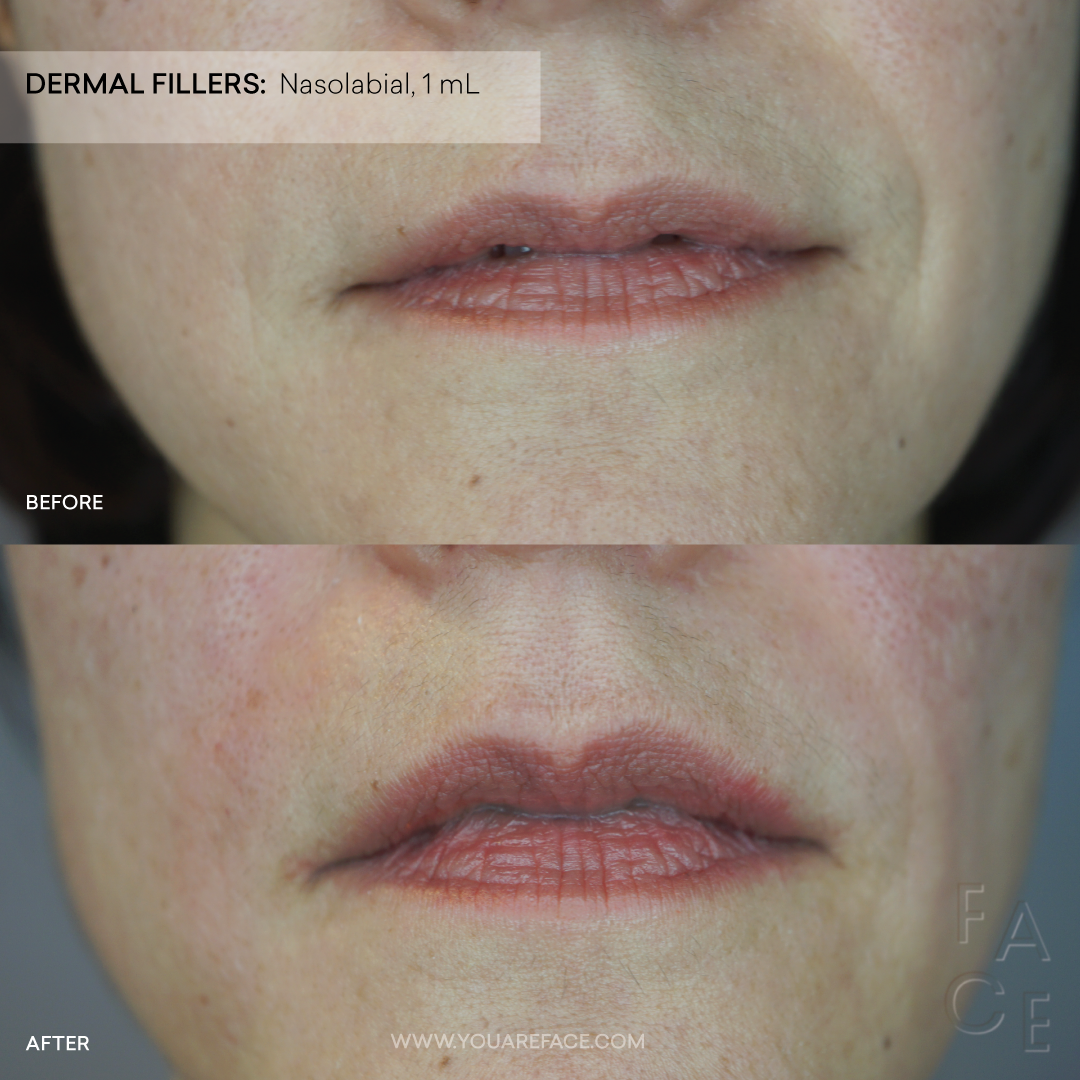What Are Hyaluronic Acid Fillers?
Hyaluronic acid (HA) fillers are a type of dermal filler used in aesthetic medicine to reduce the appearance of fine lines, wrinkles, and other signs of aging while addressing volume loss, providing lift, and enhancing features.
Dermal Filler Essentials
Restores volume, smooths wrinkles, and enhances facial contours.
Adds volume and definition to lips, cheeks, jawline, and under-eye areas.
Results are immediate and can last between 6 and 18 months.
Minimally invasive with little to no downtime.
Dermal fillers cost $750-$900 per syringe at FACE
Customizable treatments for subtle enhancement or dramatic definition.
Dermal Filler Basics
Your provider injects HA fillers directly into the skin using a fine needle or cannula. Some products are placed in the superficial dermis, while others are formulated for placement in the hypodermis or subcutaneous tissue. After fillers are placed by your injector, they absorb water from the surrounding tissues to increase volume and deliver hydration.
Hyaluronic acid is a molecule that is naturally produced by the human body—and its properties include viscosity, elasticity, lubrication, and the capacity to hold 1,000 its weight in water. When used in soft tissue for cosmetic purposes, hyaluronic acid helps make your skin look naturally plumped and hydrated.
The effects of HA fillers are temporary, with results that last from several months to a year, depending on the type of filler used, the area in which it is placed, your individual skin, and your product metabolism.
HA fillers are used for various cosmetic purposes, but for the most part, they are used to combat the aging process by correcting volume loss and enhancing features. In the US, the HA filler is dominated by Allergan, the makers of the Juvederm® filler family, and Galderma, the creators of Restylane® fillers.
Depending on their intended use, each of these formulations has a consistency, viscosity, and HA molecule size designed to deliver superior results for different facial areas and concerns. For instance, fillers designed to be used in lips have a lower viscosity, or thickness, than those formulated for use in the cheeks.
Skin Care Products
Dermal Fillers Cost
DERMAL FILLERS ABOUT
DERMAL FILLERS COST
DERMAL FILLERS BEFORE & AFTER
DERMAL FILLERS CANDIDACY & PREP
DERMAL FILLERS FAQ
DERMAL FILLERS AFTERCARE
Dermal Fillers Before & After Results
DERMAL FILLERS ABOUT
DERMAL FILLERS COST
DERMAL FILLERS BEFORE & AFTER
DERMAL FILLERS CANDIDACY & PREP
DERMAL FILLERS FAQ
DERMAL FILLERS AFTERCARE
Dermal Fillers Candidacy & Prep
Contraindications
The most common contraindications to dermal fillers are:
Known allergy or hypersensitivity to the dermal filler medication, including allergies to gram-positive bacterial proteins.
Known allergy or hypersensitivity to the anesthetic, i.e. lidocaine contained within the medication, applied topically, or injected.
Active infection near the site of injection.
Pregnancy or breastfeeding.
Under the age of 22 years.
Preparation Details
To best prepare for success with HA Dermal Fillers, follow the steps below before your appointment.
For 1 week before your appointment, avoid blood thinners & dehydrating substances like caffeine, alcohol, St. John’s Wart, Ginko Biloba, primrose oil, fish oil, vitamin E, aspirin, ibuprofen or similar products (Advil, Motrin, Aleve). They can cause bruising, bumps, more visible pinpoint marks, and lack of volume.
For 1 week before & 1 week after your dermal filler appointment, avoid tretinoin, retinal, retinoids, glycolic acid, peels, and skin-sensitizing products.
Remove all makeup in the treatment areas before your appointment.
For 72 hours before & 72 hours after your appointment, avoid highly processed foods since they greatly dehydrate the body. Instead, eat spinach, kale, and celery the week before to boost your Vitamin K levels.
Drink 1/2 gallon or more water daily for 48 hours before and after treatment. Hyaluronic Acid bonds to other Hyaluronic Acid and water.
24 hours before your filler appointment, take arnica montana tablets to help with swelling and bruising. You can also take arnica as needed afterward.
24 hours before your appointment, take an anti-inflammatory like Tylenol™ to help with swelling and bruising.
Avoid flying or saunas for 24 hours before and after your appointment, as they can dehydrate the body.
Avoid rigorous workouts for 24 hours before and after your appointments. Freshly placed fillers need time to set, so it is key to avoid vigorous movement and drink lots of water for the first 24 hours after your appointment.
1 hour before your appointment, consider taking (2) Extra-Strength Tylenol™, which may help ease injection discomfort (avoid ASA, Advil, or Motrin).
Arrive at your appointment with a clean face (or other treatment area), free of products or cosmetics.
Dermal Fillers FAQ
How do HA fillers work?
HA fillers provide immediate volume and support to the skin, attract and retain moisture, and stimulate the natural production of collagen and elastin.
When hyaluronic acid fillers are injected into the dermal layer of the skin or just below it, they provide immediate volume and support to the skin. As they absorb water, they fill in wrinkles, fine lines, and hollow areas for skin that appears smoother and more youthful. The added volume can also lift and contour specific facial areas, such as the cheeks or chin.
One of hyaluronic acid’s most helpful properties is its unique capacity to bind with and retain water molecules, which is how it helps skin stay hydrated and plump-looking. When HA fillers are injected, they attract and retain moisture in the skin, further enhancing the plumping effect and contributing to a more hydrated, radiant appearance.
Because the human body naturally produces hyaluronic acid, HA fillers are highly biocompatible—integrating well with the body’s tissues and minimizing the risk of adverse reactions. Once injected, HA fillers blend with natural HA and improve the skin’s overall texture and appearance.
What are the benefits of HA fillers?
Injectable hyaluronic acid fillers have both cosmetic benefits and therapeutic benefits. When used in aesthetic medicine, they can reduce the appearance of wrinkles, add fullness to lips, and provide lift and contour. In terms of their therapeutic applications, HA fillers can effectively treat scars, improve skin atrophy, and provide superior hydration.
Immediate results: Hyaluronic acid fillers provide instant improvements in the treated areas—one reason they have become such a popular treatment.
Natural-looking outcomes: Since the body naturally produces hyaluronic acid, fillers made from it tend to produce results that look and feel natural.
Reversible & adjustable: One unique advantage of HA fillers is that they are reversible. If you are not pleased with your results, a skillful injector can use an enzyme called hyaluronidase to instantly dissolve filler.
Minimal downtime: The minimally invasive treatment allows for a quick return to normal activities, often immediately after injections.
Hydration & volume: Hyaluronic acid is known for its incredible ability to retain moisture. When injected, it helps hydrate the skin from within—adding volume while reducing the appearance of wrinkles and sagging.
Versatility: HA fillers can be used in many areas of the face, including lips, cheeks, under the eyes, and around the mouth, making them a truly versatile aesthetic tool. They also work very well in conjunction with other treatments, like Botox®, Dysport®, and other neurotoxins.
Temporary & biodegradable: Unlike some permanent fillers, HA fillers are temporary and biodegradable. This aspect reduces long-term risks and allows adjustments over time as the face naturally changes with aging.
Safety: HA fillers have a good safety profile, especially when administered by an experienced and qualified professional. Allergic reactions are rare due to the natural compatibility of HA with the body.
Collagen stimulation: Some studies suggest that HA fillers may stimulate the production of collagen in the skin, contributing to a naturally youthful appearance over time.
While HA fillers offer many benefits, it is imperative to work with a medically qualified injector like Desiree, who can help shape realistic expectations and use her expertise in facial balancing to recommend the safest and most effective course of action to achieve your desired results.
Where can hyaluronic acid filler be used?
HA fillers have become extremely popular because they are effective, immediate, and relatively low-risk—when performed by a skilled and certified medical professional like Desiree.
Lip enhancement: Add volume and shape with lip filler to create a plump, defined pout.
Cheek filler: Restores lost volume in the cheeks to provide a more youthful and lifted appearance.
Contour & define features: Enhance the contours of your face with jawline and chin fillers for a more defined and balanced facial structure.
Forehead filler: When skillfully injected into the forehead, HA fillers smooth out wrinkles and fine lines for a rejuvenated and youthful appearance.
Correct under-eye hollows: Under-eye filler can reduce the appearance of hollows and dark circles for a naturally rested and refreshed look.
Fill wrinkles: Smile line filler can soften wrinkles around the mouth for a smoother, more youthful facial contour with minimal downtime.
Scar treatment: Certain types of scars, such as those from acne, can be smoothed out using HA fillers.
Dermal Fillers Aftercare
HA DERMAL FILLERS HEALING
Following treatment, most patients experience some redness and swelling, which may last for several hours. Occasionally, you might notice a bruise that could be visible for a few days. To minimize bruising and swelling, avoid activities that boost circulation for the remainder of the day. These include exercise, heat, and alcohol consumption.
When scheduling your appointments and social activities, remember that you may experience these temporary, minor, and unavoidable signs of treatment so you can plan accordingly.
Download Dermal Fillers Aftercare Card
Must Do:
Keep the treatment area clean and minimize contact for 24 hours.
Take arnica montana tablets as needed to alleviate swelling and bruising.
Stay hydrated by drinking plenty of water for 48 hours before and after treatment.
Avoid:
Applying makeup or products to the treatment area for at least 12 hours.
Engaging in strenuous activity for 24 hours.
Consuming alcohol and avoiding extensive sun exposure or heat for 24 hours.
Flying 48 hours before and after the appointment.
Sleeping on the treated area for 72 hours.
Highly processed foods 72 hours before and after the appointment.
Massaging the treated area for one week unless instructed otherwise by the provider.
Tretinoin, retinol, retinoids, glycolic acid, peels, or skin-sensitizing products for one week.
Remember:
Contact the office immediately with any questions or concerns.
Learn more about lip filler aftercare, like how to massage lip filler lumps here.
































